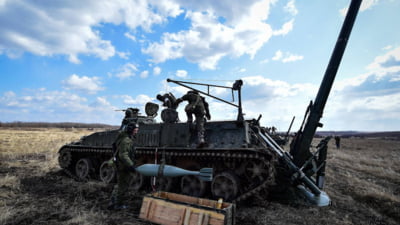🇷🇺 2S4 Tyulpan en action. pic.twitter.com/2GDC0vUNHC
— Fulgur advenit (@GrillardEric) January 2, 2023
Dubbed the “Sledgehammer,” this self-propelled 2S4 Tyulpan mortar, known as the Tulip in English, has a 240mm cannon — twice the caliber of NATO mortars, which are just 120mm — making it by far the largest caliber mortar system in the world.
It is an ancient piece, developed in the late 1960s. The first prototype was completed in 1969. It entered service with the Soviet Army in 1971. Around 450 of these artillery systems were built. Carried on its own tracks, it has a range of 19 kilometers and is used to destroy large fortifications, military equipment, or strategic positions. It was exported to Iraq (10 units) and Czechoslovakia (8 units). It saw action in Afghanistan and Chechnya. By 2000 it was still used in Czech Republic and Libya. The Czech Republic retired them and the status of Libyan mortars is unclear.
The 2S4 Tyulpan is in service in Russia and Kazakhstan (at least 2 units). By 2018, the Russian Army operated 40 of these artillery systems, plus another 390 which were kept in storage and no appear to be in Ukraine. Nowadays, they fire laser-guided rounds.
The Tyulpan is also capable of firing ZBV4 shells with nuclear warheads. When so armed, they had a range of 9.6 km and 19 km with rocket assistance and were designed to destroy cities. While, the self-propelled mortar is capable of firing nuclear bombs, it is likely to be limited to “micro-nuclear bombs” designed to destroy an area the size of a football stadium.
It can also fire armor-piercing, laser-guided, and prohibited cluster munitions, as well as tactical nuclear bombs.
At the end of the Cold War, Russia and the United States deactivated their nuclear artillery units. By 2000, Russia alleged that all nuclear artillery shells, including the ZBV4 shells for Tyulpan mortar, had been destroyed.
Ukrainian forces have targeted the mortar system on the battlefield, and some footage from drone operators has shown a number of the weapons knocked out.
Minus one Russian 240-mm self-propelled heavy mortar 2S4 Tyulpan. A Russian heavy mortar burst into flames. The fire was extinguished, but the mortar was disabled. pic.twitter.com/b6bR12kd0w
— Paul Jawin (@PaulJawin) January 2, 2023

